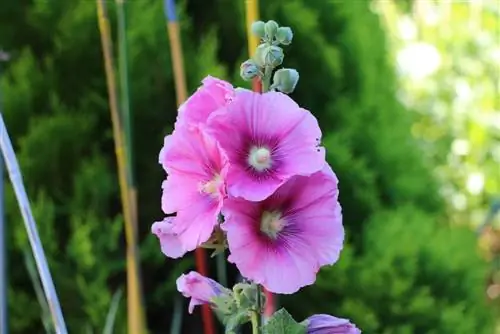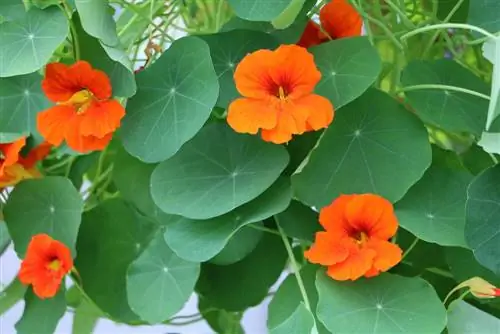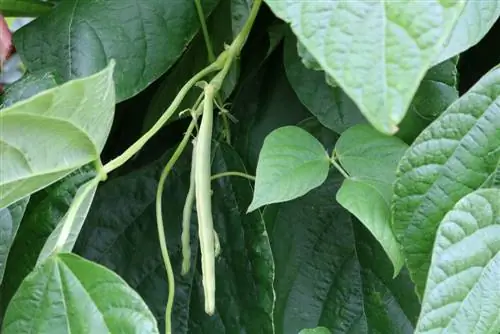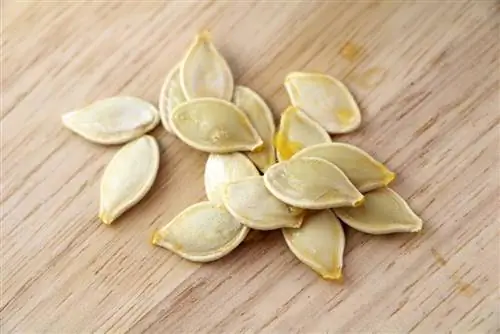- Author admin [email protected].
- Public 2023-12-17 03:39.
- Last modified 2025-01-24 12:45.
Hollyhocks are the typical plants from cottage gardens and which like to show off themselves simply because of their size. Hollyhocks belong to the mallow family and have many uses in the garden. It is suitable as a solitary plant, for perennial beds, where it should be in the back row due to its size, or can be skillfully displayed along house walls.
Choice of varieties
There are now numerous varieties of hollyhocks that differ in shape and flower color. The most common representatives include varieties in delicate yellow or strong pink orshades of red. A special highlight is the “Nigra” variety, which impresses with its dark red to almost black-red flowers. Varieties such as the hollyhock Parkallee, which is two-colored, are also attractive. The petals are a pale yellow, while the stamens stand out in a rich dark purple. In addition to the open flower forms, there are also hollyhocks in a wide variety of colors with large double flowers. Depending on the location, the flowers can sometimes reach the size of the palm of your hand when fully open.
Sowing
Hollyhocks are biennial, which means that they are sown in the first year and only develop flowers in the second year. Hollyhocks can be sown all year round in normal, non-frozen garden soil.
- Seeds: The different varieties can be purchased commercially. The hollyhock can later be propagated using self-grown seeds. Propagation can also occur via self-sowing. The seeds are sown again immediately after maturity.
- Cultivation: Sowing should take place in September at the latest so that the hollyhock blooms next year. The hollyhock has no special requirements when sowing.
- Pre-culture: Pre-culture is generally not necessary. However, if sowing is only carried out in late autumn or early spring, it is recommended to pre-culture at an optimal germination temperature and overwinter in a cool cellar or glasshouse.
- Planting distance: The hollyhock should be at least 40 cm away from other plants. Plants grown in a seed tray must be pricked out as soon as the first pair of leaves have formed.
- Temperature: Hollyhocks require a temperature of at least 20 °C to germinate.
- Germination time: The seeds usually need two to three weeks to germinate.
- Separate: If there is not enough space, it makes sense to separate the plants in the spring of the next year so that they can develop well. No more than five hollyhocks should be planted per square meter so that they do not hinder each other's growth.
- Soil: In the first year, the hollyhock is relatively demanding, but in the following year it needs sufficient nutrients for beautiful flowers. However, when direct sowing in the garden, the soil can be prepared for the next year when sowing, for example by incorporating organic fertilizer such as compost or horn shavings into the soil.
- Location: The location itself should always be sunny for hollyhocks, but also protected from wind so that they do not break off so quickly due to their height.
Tip:
With hollyhocks, unsightly walls can be easily beautified without having to install trellises or damaging the wall. The wall itself acts like a frame for the hollyhocks and also radiates heat to the plants in the evening that was stored during the day.
Care
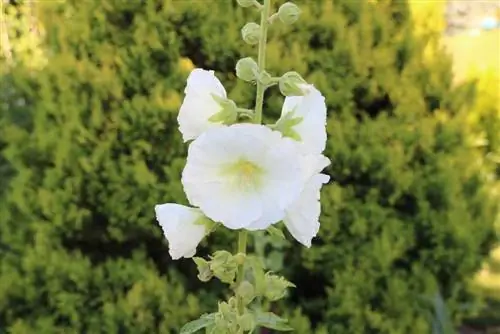
Hollyhocks do not require any extensive care and in the first year you should only make sure that they are not overgrown by weeds or other plants. The soil around the hollyhocks should be loosened regularly, which can happen when fertilizers are incorporated. However, when loosening the soil, care should be taken not to damage the large rosette of leaves on the ground. It keeps the ground around the hollyhock shady and prevents the soil from drying out quickly.
- Fertilizing: In the second year, however, the mallow plant should be regularly supplied with nutrients or fertilizer. This supports growth and at the same time promotes the formation of large flowers, which begin to bloom around July.
- Watering: The hollyhock needs an evenly moist soil that must not dry out. In the event of longer dry periods, the hollyhock should be watered several times a day to maintain constant moisture.
- As part of caring for hollyhocks, it is also necessary to provide good support. The plants can often reach up to three meters, which means there is a high risk of them breaking in wind or heavy rain. When choosing a support, care must be taken to ensure that it is high enough and that the material used to tie it down does not cut into the plant. It is best to use old fabric scraps or stockings for tying, which also gives the plant some flexibility in light winds.
Tip:
In order to additionally support the hollyhock in storing moisture and to keep water consumption low, additional bark mulch can be applied around the plant.
Diseases and pests
- Snails: Protect from snails in the first year. In the spring of the second year, care must also be taken to ensure that the first shoots of the hollyhock are not immediately eaten away by the snails.
- Mallow rust: Only the so-called mallow rust can be dangerous to the plant. This fungal disease prefers to attack plants that have too little space and the air exchange is not good. Although mallow rust does not endanger the plant, it should be combated because the fungus causes unsightly spots that look like rust and can also affect other mallow plants, such as marshmallow. In the first step, the affected plant parts are cut off and disposed of in the residual waste. If this does not help, a light fungicide can also be used.
Frequently asked questions
Are hollyhocks perennial?
There are biennial and perennial varieties of hollyhocks. In any case, cultivation takes place in the first year and the hollyhocks produce flowers for the first time in the second year.
Are hollyhocks suitable for growing in pots?
The hollyhock is only partially suitable for cultivation in pots. The risk of it drying out is significantly higher. In winter the pots must be particularly protected so that the roots do not freeze.
What you should know about sowing hollyhocks soon
Seeds
You can buy hollyhock seeds. However, it is often a good idea to collect seeds while walking along other people's gardens. Of course, you should always ask for permission. You usually leave the seedlings on the plant, only if there are too many of them should you remove some. Once they are really ripe, they can be used for sowing. The hollyhock also sows itself. After flowering, the plants usually die. New, small plants take over their place. They will bloom next year. Only unfilled offspring are formed from seeds of double hollyhocks.
Sowing
- If you don't want to sow directly into the bed, you can also use plant bowls or small plant pots.
- It is best to sow directly after the harvest. The seeds take about 2 to 3 weeks to germinate.
- In July/August the temperatures outside are high enough so that they germinate well at 20˚C, the temperature they need.
- If you have sown in a planting tray, the plants must be pricked out.
- The small pots can be placed in the garden soil in autumn, before there is frost.
- To be on the safe side, it's better to cover them with some brushwood.
- If you want to plant in spring, start sowing in February/March, then indoors of course.
- From April/May you can also sow directly outdoors. The early plants are planted in the garden after the Ice Saints until the beginning of June.
- Hollyhocks grown in spring do not bloom until the following year.
- The seeds are only lightly covered with soil, this is necessary for germination. This is important outdoors so that the seeds don't fly away.
Planting out
- As soon as the young plants have reached a certain size, they are planted out.
- The right time is around the end of August to mid-September.
- The earlier the plants are placed in the garden soil, the better they can form roots before winter.
- If planted late, the hollyhock usually doesn't fully develop its magnificent flowers until the year after next.
- Leave a distance of about 50 cm between the plants. Expect 5 plants per square meter.
- The young hollyhocks are placed in a sunny to semi-shady place, where they are somewhat protected from the wind.
- Otherwise you have to tie the long flower stems well.
- The hollyhocks are best planted at a row spacing of 50 cm with a distance of 40 cm to 60 cm between the individual plants.

